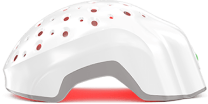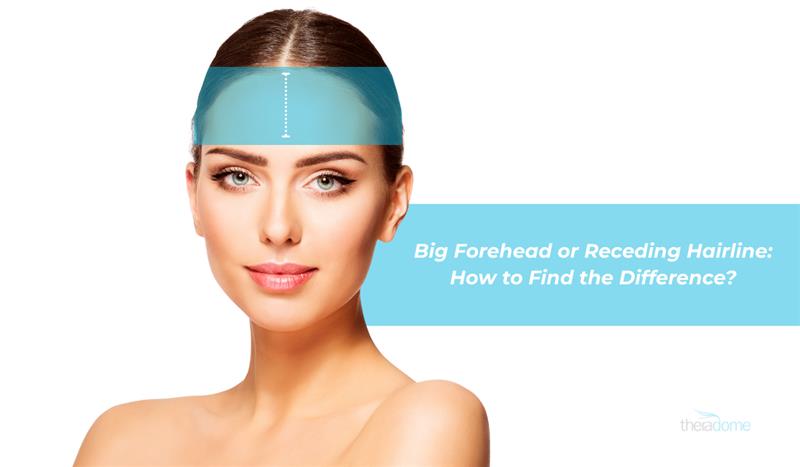Plenty of people panic over their hairline without knowing what’s actually happening. Is it just genetics doing its thing, or is your hairline staging a slow exit? That’s the million-dollar question. The problem is, the line between a big forehead or receding hairline isn’t always clear—especially when you're staring at it through the harsh light of a bathroom mirror.
A high forehead doesn’t always mean trouble, and a shifting hairline isn’t always benign. But knowing the difference could be the reason you keep your density—or lose it. What’s worse? Waiting too long to care because you thought you were imagining things.
Let’s cut the confusion. Here’s how to tell if your hairline is naturally wide or waving goodbye.
What is a Big Forehead?
A big forehead is exactly what it sounds like: a wider-than-average space between your eyebrows and your hairline. Most of the time, it's just genetic code doing what it does best. You were likely born with it. The defining trait here is stability. A big forehead doesn’t sneak up on you—it’s been there since school photos were a thing.
Unlike hairline recession, a naturally high forehead tends to have a clean, curved border. You won’t see random dips, sharp widow’s peaks, or temple retreats. Density along the front is even, and the shape is consistent. People with big foreheads don’t wake up one day wondering if their scalp is playing hide-and-seek. If your hairline looks today like it did five, ten, or fifteen years ago, it’s not receding—it’s just structurally high. And unless it’s causing you grief, it’s not a flaw. It’s a feature.
What is a Receding Hairline?
Now we’re in very different territory. A receding hairline isn’t just a wide frame—it’s movement. It’s what happens when hair follicles shrink, weaken, and eventually stop producing hair altogether. This slow retreat is usually the work of androgenetic alopecia (hereditary hair loss), but it can also come from chronic tension, hormone shifts, or inflammatory scalp issues. The key trait is change over time. And unless you're actively watching for it, it often slips under the radar.
The signs of a receding hairline include thinning at the temples, a loss of definition along the hairline, and a noticeable M or V shape creeping in. You may also notice those fine, baby-like hairs replacing thicker strands at the front. It’s not the same as a mature hairline, which is a normal part of aging in men and doesn’t necessarily signal active hair loss. But once you pass the "mature" threshold into actual recession territory, things get real—and fast.
Main Differences between a Big Forehead and Receding Hairline
They might seem similar at first glance, but the difference between a big forehead and a receding hairline becomes obvious once you know what to look for.
1. Hairline Shape
A big forehead comes with a consistent, rounded, or oval hairline. The temples don’t sink. The shape is symmetrical. Basically, no architectural surprises.
In contrast, a receding hairline is marked by unevenness—especially around the temples. The hairline often dips into an M shape, or the edges thin out while the center holds on. That asymmetry is recession, not genetics.
2. Change Over Time
A high forehead stays put. It doesn’t drift, shift, or retreat with age.
A receding hairline, however, is a moving target. What was once a low frame starts migrating north—often gradually, sometimes aggressively, but never by accident.
3. Hair Density
Hair density at the edge of a big forehead is typically full. The front line may be high, but it’s not sparse.
With a receding hairline, thinning is obvious. The strands lose their strength, and patches of scalp begin to show through.
4. Age Factor
Big foreheads are forever. If you had it in your teens, you’ll likely have it in your 50s—no shift, no stress.
Receding hairline stages usually begin in your late teens to early 30s. And unless you catch it early, that slow fade tends to accelerate with age.
Common Causes of Big Forehead and Receding Hairline
Big Forehead Causes:
- Genetic inheritance
- High hairline from birth
- Skull-to-face proportions
Receding Hairline Causes:
- Androgenetic alopecia
- Hormonal fluctuations (e.g., pregnancy, menopause, thyroid)
- Chronic tension or traction
- Scalp inflammation or infections
Treatment Options for Receding Hairline
There’s no one-size-fits-all here—but there are proven options. FDA-approved meds like minoxidil and finasteride work to halt further loss and in some cases, promote regrowth. They’re most effective when started early, before the follicles shut down completely.
If things have already thinned out, a hair transplant for receding hairline may be on the table. Follicles are moved from dense zones to sparse ones—assuming your donor area is healthy. And if you’re after something non-invasive, low-level laser therapy/laser phototherapy like Theradome offers a science-backed way to stimulate regrowth without drugs or downtime.
But it’s not just for solo use—LPT/LLLT is now routinely recommended by top hair restoration professionals both before and after transplant surgery. Why? Because laser phototherapy helps create a healthier scalp environment, improves blood flow, and boosts the odds of delicate grafts actually surviving and thriving once they’re relocated. Devices like FDA-cleared helmets, combs, or caps are being used not just for maintenance—but to support surgical outcomes that stick.
As for surgical alternatives, forehead reduction surgery may help those with structurally large foreheads—not those with active hair loss. So make sure you know what you’re working with before going under the knife.
Lifestyle tweaks can help, too. Reduce chronic scalp tension. Use products that support follicular health. Watch out for stress-related habits that contribute to thinning. And when in doubt, see a dermatologist—not your barber—for real answers.
Conclusion
The big forehead or receding hairline debate is follicular detective work. One is structural, the other is progressive. One stays put, the other backs out like a slow-motion breakup. Knowing the difference means you’ll stop wasting time wondering and start doing something—whether it’s treating hair loss early, changing your hairstyle, or simply owning your natural look. Either way, you’re not alone, and you’re definitely not powerless. Because now you don’t just see it—you understand it.






















